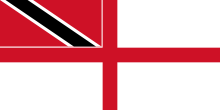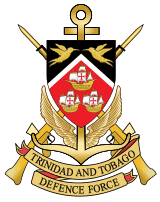Trinidad and Tobago Defence Force
| Trinidad and Tobago Defence Force | |
|---|---|
|
Trinidad and Tobago Defence Force emblem | |
| Founded | 1962 |
| Service branches |
Trinidad and Tobago Regiment Air Guard Coast Guard Trinidad and Tobago Defence Force Reserves |
| Headquarters | Chaguaramas |
| Leadership | |
| Commander-in-Chief | Anthony Carmona |
| Minister of National Security | Major General Edmund Dillon (Ret'd) |
| Chief of Defence Staff | Brigadier General Rodney Smart |
| Manpower | |
| Military age | 18 (17 with parental consent) |
| Expenditures | |
| Percent of GDP | 0.3% |
The Trinidad and Tobago Defence Force (TTDF) is the military organization responsible for the defence of the twin island Republic of Trinidad and Tobago. It consists of the Trinidad and Tobago Regiment, the Coast Guard, the Air Guard and the Defence Force Reserves.
Established in 1962 after Trinidad and Tobago's independence from Britain, the TTDF is one of the largest Military forces in the English speaking Caribbean. Its mission statement is to "defend the sovereign good of The Republic of Trinidad and Tobago, contribute to the development of the national community and support the State in the fulfillment of its national and international objectives". The Trinidad and Tobago Defence Force is made up of four distinct arms; The Regiment/Army, the Coast Guard, the Air Guard and the Defence Force Reserves, which all fall under the authority of the Ministry of National Security. The TTDF has the world's only Military steelband.
The Commander in Chief of the Defence Force is the country's President, Anthony Carmona. The current Chief of Defence Staff is Brigadier General Rodney Smart
Regiment (Army)

The Trinidad and Tobago Regiment is the main ground force element of the Trinidad and Tobago Defence Force. It has approximately 3000 men and women organized into four (4) battalions and a Regiment Headquarters. The regiment has two primary roles; Maintaining the internal security of Trinidad and Tobago and support to civil law enforcement.
Also, as one of the larger military forces in the region, the Trinidad and Tobago Regiment is also one of the main units used in peacekeeping and humanitarian situations from the Caribbean region.
Although it is called the Trinidad & Tobago Regiment, the TTR is in fact structured more like a light infantry brigade, with a pair of infantry battalions, plus engineering and logistic support units:
1st Battalion (Infantry), Trinidad and Tobago Regiment: This is a light infantry battalion. It is located at Camp Ogden, Long Circular Road, St James.
2nd Battalion (Infantry), Trinidad and Tobago Regiment: This is also a light infantry battalion. Formerly located at Camp Mausica, since then it has been relocated to the Chaguaramas Heliport and La Romain.
3rd Battalion (1st Engineer Battalion): This provides engineering support, humanitarian assistance and disaster relief. It is located at Camp Cumuto, Wallerfield.
4th Battalion (Support and Service Battalion): This provides logistic and administrative support for the regiment. It is located at the Teteron Barracks, Teteron Bay, Chaguaramas.
The Regiment also maintains a Camp Omega, also at Chaguaramas, which is used primarily for infantry training.
Special Forces
Trinidad and Tobago has a unique and highly trained group of special forces that is tasked to fulfill counter narcotics and counter terrorism operations. Soldiers are sent to the United States or the United Kingdom for their training.Their motto is "to find a way"
Air Guard

The Air Wing of the Trinidad and Tobago Defence force was formed in February 1966, and was initially part of the Coast Guard and was called the Air Wing of the Coast Guard or the Air Wing. In 1977, it was separated as its own entity. In 2005 it was renamed the Trinidad & Tobago Air Guard (TTAG). Its bases are at Piarco International Airport, Crown Point International Airport, and the Heliport at Chaguaramas. Its purposes are to protect and patrol Trinidad and Tobago's airspace, and is also used for transport, search and rescue, and liaison. The current commander of the Air Guard is Group Captain Darryl Daniel. He has taken command of the unit in August 2014.[1]
Aircraft
Current inventory
| Aircraft | Origin | Type | Variant | In service | Notes | |
|---|---|---|---|---|---|---|
| Maritime Patrol | ||||||
| C-26 Metro | United States | maritime patrol | 2[2] | |||
| Helicopters | ||||||
| AW139 | Italy | utility / SAR | 4[2] | |||
Its former fleet of aircraft included: One Cessna 337 (O-2A) Skymaster (1966–1972), One Cessna 402 Utililiner (1972–1998), four Aérospatiale Gazelle (1973–1995), One Cessna 172 Skyhawk (1991–1998), Two Piper Navajo 2000-2009, One Cessna 310 1985-2011
Aircraft ordered: Four (04) Agusta Westland AW139 Helicopters. Two (02) of the helicopters were delivered in May 2011, and the other Two in July 2012 . The helicopters will be used by the Trinidad & Tobago Air Guard for surveillance and reconnaissance missions related to search and rescue, border patrol and drug interdiction.
The Minister of National Security announced that the establishment of a military airfield, construction of an operations/administrative building at the Piarco Air Station and new helicopters would be purchased to equip the Air Guard. The minister also promised training from various international bodies. Cabinet agreed to the change of rank designations from naval to the corresponding aviation designations and the creation of 66 ranks on the establishment of the Air Guard. However even though it is separate TT Air guard still reports to Coast Guard officials.
Coast Guard


The Trinidad and Tobago Coast Guard is responsible for the maritime capabilities of the TTDF. The Coast Guard consists of a number of vessels designated CG<number>. The current Commanding Officer is Captain (N) Hayden Pritchard.
Its mission statements is to "To Defend the Sovereign Good of the Republic of Trinidad and Tobago and to provide on a continuous basis, quality service for security and safety within the Maritime Boundaries, and in any other area of responsibility agreed to by the State to fulfill its International Obligations".
The Coast Guard is primarily involved with the Drug Trade interdiction as well as Search and Rescue within the waters of Trinidad and Tobago and neighbouring Islands.[3] However the Coast Guard has been involved in major incidents. During the 1970 Army Mutiny in Trinidad and Tobago, the Coast Guard prevented the mutineers from convoying to Port of Spain by firing on an access road from the Regiment base at Teteron Barracks in Chaguaramas.
National Roles of the Trinidad and Tobago Coast Guard include:
- Surveillance of the Waters under T & T Jurisdiction
- Logistical Support to T & T Land Forces
- Port Security (ISPS Code)
- Assistance in Scientific Research
- Aid to Civil Law Enforcement
- Anti-Smuggling / Counter-Narcotic Operations (MOF)
- Fisheries Protection and Enforcement (MAL&MR)
- Pollution Surveillance and Enforcement (MPU&E)
- Safety of Shipping (MOW&T)
Operational Tasks
- Keeping surveillance of the nation's off-shore installations
- Environmental protection, minor salvage and local maritime surveys
- Cooperating with other naval forces.
Fleet
The Coast Guard planned to acquire three Offshore Patrol Vessels; The Port of Spain class corvette, which have been built by BAE Systems Surface Ships in the United Kingdom. However, in September 2010, the Government of Trinidad and Tobago announced it was cancelling the order.[4]
On 29 April 2015 the Ministry of National Security contracted with Dutch company Damen Shipbuilders for four 51-metre 28-knot coastal patrol vessels, two 54-metre fast utility boats and six 11-metre 53-knot interceptors.[5][6][7]
Defence Force Reserves
The Defence Force Reserves, previously called the Volunteer Defence Force, is the non active duty arm of the Trinidad and Tobago Defence Force. Its mission statement is "To be a highly professional, well trained combat ready force that will respond effectively in support of our regular forces and the national community". The Defence Force Reserves is capable of providing reinforcement and be a force multiplier in the event that the Defence Force is called upon to carry out its roles of aid to the civil power. Established in September 1963, its primary purpose at that time was to provide essential reinforcements to the regular force. Today, those roles have grown to include assisting in the promotion of hemispheric and international security and development, with a well equipped force, trained in a broad range of disciplines and actively involved in community development.In recent years, the Reserves have been called out to assist with law enforcement and most recently to assist with the security in Trinidad's hosting the 5th Summit of the Americas in 2009.
References and links
- ↑ http://www.news.gov.tt/archive//E-Gazette/Gazette%202014/Gazette/Gazette%20No.%20140%20of%202014.pdf
- 1 2 "World Air Forces 2015 pg. 31". Flightglobal Insight. 2015. Retrieved 4 February 2015.
- ↑ Susan Mohammed (2017-03-02). "T&T Coast Guard in $837 million drug bust: ...fishing vessel intercepted off Suriname". Trinidad Express. Retrieved 2017-03-03.
THE Trinidad and Tobago Coast Guard partnered with the United States Coast Guard and other Caribbean countries in a drug-bust that led to the interception of over $837 million worth of cocaine.
- ↑ Sibun, Jonathan (2010-10-06). "BAE faces £150m hit as Trinidad and Tobago cancels drug-busting patrol ship deal - Telegraph". The Daily Telegraph. London. Retrieved 2010-10-06.
- ↑ "Signing of Shipbuilding Contracts and Overall Agreement for construction of Naval Assets" (PDF). Ministry of National Security. Retrieved 10 May 2015.
- ↑ "The T&T Coast Guard is getting these naval vessels". Trinidad Express Newspapers. 29 April 2015. Archived from the original on 1 May 2015. Retrieved 10 May 2015.
- ↑ "Trinidad and Tobago Coast Guard contracts Damen for fleet of coastal patrol craft". Gorinchem: Damen Shipyards Group. 14 May 2015. Retrieved 13 January 2016.
External links
- Trinidad and Tobago Defence Force official web site
-
 This article incorporates public domain material from the CIA World Factbook document "2003 edition".
This article incorporates public domain material from the CIA World Factbook document "2003 edition".
